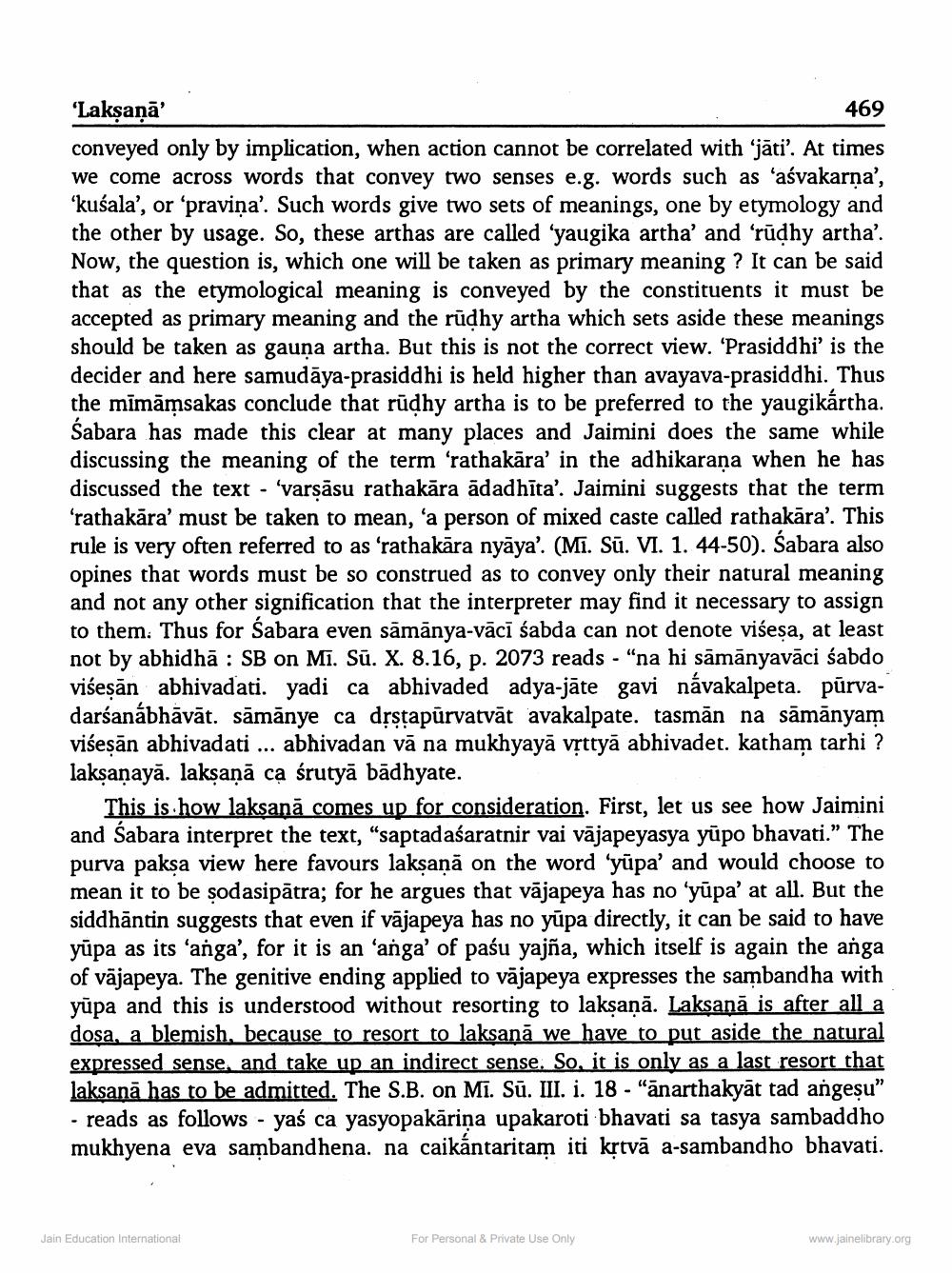________________
'Lakşaņā
469 conveyed only by implication, when action cannot be correlated with 'jāti'. At times we come across words that convey two senses e.g. words such as 'aśvakarna', ‘kusala', or 'praviņa'. Such words give two sets of meanings, one by etymology and the other by usage. So, these arthas are called 'yaugika artha' and 'rūdhy artha'. Now, the question is, which one will be taken as primary meaning ? It can be said that as the etymological meaning is conveyed by the constituents it must be accepted as primary meaning and the rūdhy artha which sets aside these meanings should be taken as gauna artha. But this is not the correct view. 'Prasiddhi' is the decider and here samudāya-prasiddhi is held higher than avayava-prasiddhi. Thus the mīmāmsakas conclude that rūdhy artha is to be preferred to the yaugikártha. Sabara has made this clear at many places and Jaimini does the same while discussing the meaning of the term 'rathakāra' in the adhikarana when he has discussed the text - 'varsāsu rathakāra ādadhīta'. Jaimini suggests that the term ‘rathakāra' must be taken to mean, 'a person of mixed caste called rathakāra'. This rule is very often referred to as 'rathakāra nyāya'. (Mi. Sū. VI. 1. 44-50). Sabara also opines that words must be so construed as to convey only their natural meaning and not any other signification that the interpreter may find it necessary to assign to them. Thus for Sabara even sāmānya-vācī sabda can not denote višesa, at least not by abhidhā : SB on Mi. Sū. X. 8.16, p. 2073 reads - "na hi sāmānyavāci śabdo višesān abhivadati. yadica abhivaded adya-jāte gavi návakalpeta. pūrvadarśanabhāvāt. sāmānye ca drstapūrvatvāt avakalpate. tasmān na sāmānyam viśeşān abhivadati ... abhivadan vā na mukhyayā vịttyā abhivadet. katham tarhi ? lakṣanayā. laksaņā ca śrutyā bādhyate.
This is how laksană comes up for consideration. First, let us see how Jaimini and Sabara interpret the text, “saptadaśaratnir vai vājapeyasya yūpo bhavati.” The purva paksa view here favours laksana on the word 'yūpa' and would choose to mean it to be sodasipātra; for he argues that vājapeya has no 'yūpa' at all. But the siddhāntin suggests that even if vājapeya has no yūpa directly, it can be said to have yūpa as its ‘anga', for it is an 'anga' of pasu yajña, which itself is again the anga of väjapeya. The genitive ending applied to vājapeya expresses the sambandha with yüpa and this is understood without resorting to laksanā. Laksanā is after all a dosa, a blemish, because to resort to laksanā we have to put aside the natural expressed sense, and take up an indirect sense. So, it is only as a last resort that laksanā has to be admitted. The S.B. on Mi. Sū. III. i. 18 - "ānarthakyāt tad angesu" · reads as follows - yaś ca yasyopakārina upakaroti bhavati sa tasya sambaddho mukhyena eva sambandhena. na caikántaritam iti krtvā a-sambandho bhavati.
Jain Education International
For Personal & Private Use Only
www.jainelibrary.org




